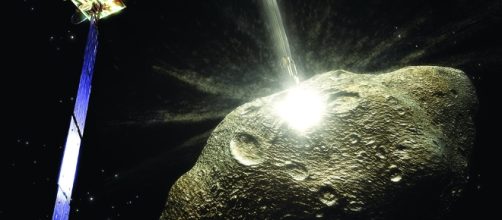MIT News is reporting on a project by space engineering students at that institution to design a mission to the asteroid Apophis. Apophis is an Earth-approaching asteroid that is measured between 330 and 350 meters in diameter. It will pass by relatively close to the Earth in 2029 no closer than 31,200 kilometers. Apophis will visit the vicinity the Earth in 2036, but no closer than 23 million kilometers. In neither case is there any chance that the asteroid will hit the Earth.
Why Apophis?
While a number of NASA and other national space agencies have flown missions to asteroids, Project Apophis is designed to be the first that would monitor such a body from space as it flies by Earth, with its course being changed by that planet’s gravity.
Thus, the MIT students propose that the effects of the Earth and other planetary bodies on the movement of asteroids would be examined. The results of such a mission would have implications for both planetary defense against asteroid impacts and efforts to intercept and mine such celestial bodies.
The Apophis asteroid mission
The proposed asteroid probe would carry four instruments that would characterize the structure and movement of Apophis, LORRI (Pan-Chromatic High-Resolution Imager), Ralph (Color and Spectral Imager), TES (Thermal Emission Spectrometer), and RRT (Radio Reflective Tomography). The mission will look at the surface properties, orbital characteristics, and thermal emissions of the asteroid over multiple orbits.
The asteroid probe will follow Apophis as it passes by Earth in 2029. The probe would launch in August 2026, rendezvous with the asteroid in March 2028, and end its mission in 2033.
Project reviewed by NASA experts
The students, guided by their faculty advisors Richard Binzel and David Miller, presented their project in a series of design reviews that culminated in a final design review attended by NASA scientists and engineers from the space agency’s headquarters and the Jet Propulsion Laboratory.
The NASA experts asked the students some pointed questions that will guide them in their efforts in refining the mission further. However, NASA Planetary Defense Officer Lindley Johnson pronounced the project a good effort, stating, “It’s almost ready for a NASA proposal.”
Could the student project become a real space mission?
Whether or not the MIT student project could become a real space mission would depend on issues such as cost and competing mission concepts.
NASA does not have enough funding to fly every worthy space mission proposal. However, it should be noted that both China and the European Space Agency are contemplating missions to Apophis. On the other hand, if NASA does pass on the MIT Apophis mission, private funding might be available from one or more of the start-up asteroid mining companies.


